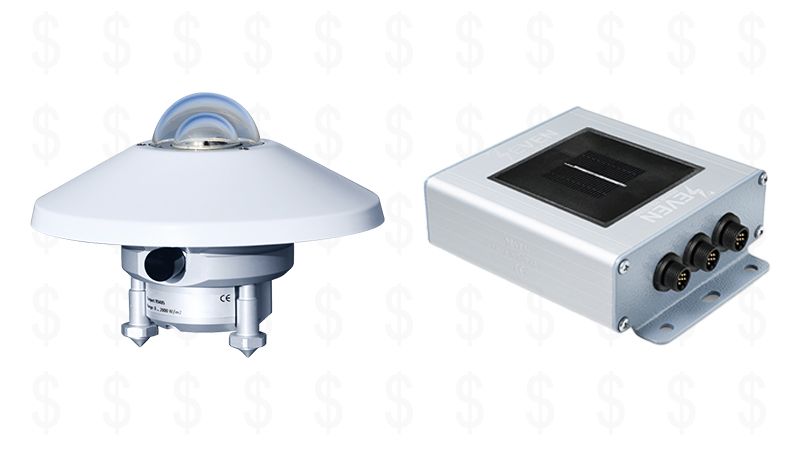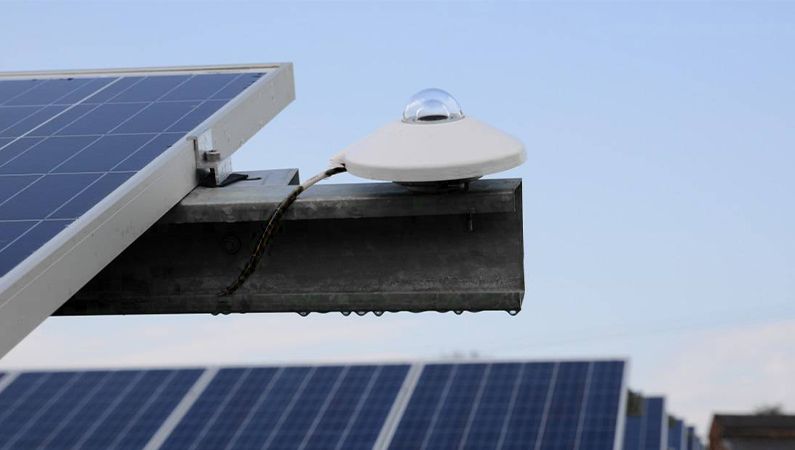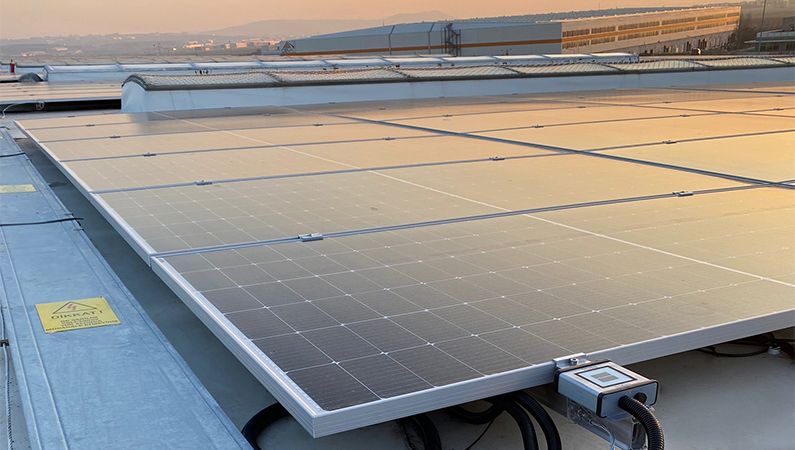Your cart is currently empty!
What is the Price of Irradiance Sensor and Pyranometer

Irradiance sensors and pyranometers are used to measure the amount of irradiance that reaches a PV panel’s surface. This information is then used to calculate the expected energy output of the PV panel system.
Introduction to Irradiance Sensors and Pyranometers
Both terms define the same thing; a device that measures the irradiance. However, usually, in the market, pyranometers refers to thermopile pyranometers with a glass dome and Irradiance Sensor refers to calibrated reference cell.
What is Pyranometer?
A thermopile pyranometer consists of several thermocouple junctions connected in series, which detect the amount of heat generated by the absorption of radiation. This heat is converted into an electrical current that is proportional to the intensity of the radiation. The thermopile is enclosed in a protective housing with a glass dome. Thermopile pyranometers are used in other fields than solar energy, such as meteorology, agriculture, and environmental science.

What is Irradiance Sensor?
A reference cell irradiance sensor is made of a monocrystalline silicon photovoltaic cell, which is activated by light and produces an electric current that is converted to millivolts (mV) due to the shunt resistor mounted on its back side. SEVEN Irradiance Sensor is including an electronic card designed to calculate temperature-compensated irradiance value in W/m² unit. The calibrated cell irradiance sensor is mounted in the Plan of Array (POA) to measure the POA irradiance value.

What is the difference between the Pyranometer and Irradiance Sensor?
Both Irradiance sensor and pyranometer are used to measure the amount of irradiance that reaches a PV panel’s surface, which is then used to calculate the expected energy output of the PV panel system. There are some differences between the two devices as summarized in the following table.
| Irradiance Sensor | Thermopile Pyranometer | |
|---|---|---|
| Production Technology | Photovoltaic technology | Thermopile technology |
| Measuring Mechanism | A photovoltaic cell that converts the energy in the incident light into a small electrical current. | A thermopile that generates electricity when it is heated by the sun’s radiation |
| Class Options | Class A, Class B | Class A, Class B, Class C |
| Standard | IEC61724-1 | ISO 9060:2018 |
| Output Options | Modbus RTU, 4-20mA, 0-1,5V | Modbus RTU, 4-20mA, 0-10V |
| Measuring Range | 0 – 1600 W/m2 | 0 – 2000 W/m2 |
| Accuracy* | < 2% | < 2% |
| Price* | 400 EUR | 2000 EUR |
* For Class A Modbus Models
The main difference between Irradiance Sensor and Pyranometer is that the irradiance sensor is used to measure the Plan of Array irradiance (POA) and is made of a calibrated cell to be suitable for PV Panels, while the thermopile pyranometer is designed and manufactured by using different technology and used to measure the Global Horizontal Irradiance (GHI) for meteorological purposes. To check more details about the technical difference between these two models, you can check our previously written article.
Factors that Affect the Prices of Irradiance Sensors and Pyranometers
The cost of manufacturing irradiance sensors and pyranometers greatly affects their price. This includes the cost of raw materials, labor, and other associated costs. Actually, thermophile technology is more expensive than PV technology, even if both devices are used for the same purpose.
The Price of Irradiance Sensor and Pyranometer
Over the years, SEVEN has worked on the prices of irradiance sensors and pyranometers to be competitive in the PV market. The prices of these devices have become more affordable, making them accessible to more customers. As a reference the price of pyranometer is as follows;
- Thermopile Pyranometer Price: 2000 Euro/Ea
- Reference Cell Irradiance Sensor Price: 400 Euro/Ea
While the price of a class A thermopile pyranometer is around 2000 EUR, the prices of a Class A POA irradiance sensor varies between 250 EUR and 700 EUR as per the Output of the sensor and the number of connectable external sensors for the Modbus models. In addition, SEVEN has recently developed a Low-Cost Irradiance Sensor for Residential Projects which costs less than 200 EUR. In addition, SEVEN doesn’t hesitate to apply a discount on project as per the ordered quantity.
The mentioned prices can be subject to modification either positively or negatively due to the fluctuation of component prices in the market. However, SEVEN tries always to keep its prices as affordable as possible to satisfy the budget of its clients.
Irradiance Sensor and Pyranometer Models
SEVEN produces different models of Irradiance Sensors to satisfy the need of the PV Market. It provides many different options for Class A Irradiance Sensors. The main classification can be done by the type of communication output; Either it is Modbus RTU, 4-20mA, or 0-1,5V SEVEN can offer you the requested model.
As mentioned previously, there are many models of Irradiance Sensor with Modbus RTU Output depending on the number of connectable external sensors. The main reason for the several options SEVEN provides for this model is to offer the best price to the client with no unnecessary extra features. Other than the standard Irradiance Sensor, SEVEN produces a special model for dual and quad-orientation plants as well.
In another hand, SEVEN offers a Class A Pyranometer as it is the most required class in the market. SEVEN recalibrate the Pyranometers in its factory in Türkiye by using a Class AAA Sun Simulator. Once it is time for recalibration, you can get in touch with the sales team to explain to you the procedure to follow.